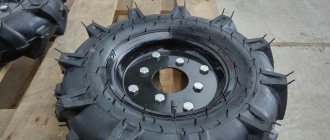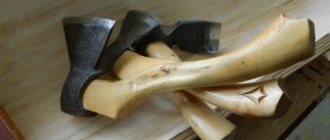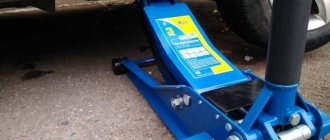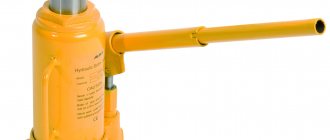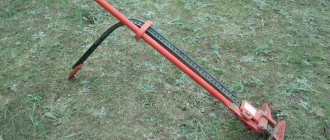One of the most popular tools needed for many jobs (car repair, house construction, etc.) is a jack. Those who have had to carry out lifting work on their own know that hydraulic lifts have many advantages over mechanical ones: structural rigidity, stability and smooth operation, and high efficiency. The oil in such equipment must be changed periodically. Therefore, today the question of how to properly fill a hydraulic jack is relevant.
Hydraulic jacks are one of the most popular tools when repairing a car or an old house.
Scope of application of hydraulic jacks
hydraulic jack
Although jacks are most often used in everyday life to replace tires on cars, the range of their use is much wider:
- lifting car bodies during repairs;
- raising the bridge span;
- tension of high voltage power lines;
- laying water pipes directly through the ground without digging trenches;
- spring compression;
- movement of large building blocks, large parts and mechanisms.
The fundamental differences between jacks and other lifting mechanisms:
- small size;
- ease of operation;
- reliability and durability;
- During operation, the mechanism is located only under the load.
Refueling mechanisms
Next, we’ll look at how to properly fill the recommended oil into a jack. Sometimes, if transported incorrectly, hydraulic fluid can spill out and the voids can be filled with air. This will cause the jack to fail. In this case, an oil change is necessary.
The rack and pinion mechanism is quite large; it is used not only for lifting the body, but also for repairing old buildings. Before changing the lubricant, the mechanism must be completely lowered. To verify this, you can relieve residual stress by turning the exhaust valve counterclockwise.
The neck into which the filling is made is usually located on the tank body, usually in the lower part of the cylinder. It is necessary to free the neck from the bolt or plug that reliably protects the oil in the container. Then you will need an oil can, the nozzle of which must be inserted into the neck and filled.
Changing the oil in the jack
One of the reasons for slow operation or complete stop of the jack may be oil leakage during transportation or improper storage. Air takes the place of the working fluid, which has a bad effect on functionality.
Before adding new oil, it is advisable to disassemble the jack and thoroughly clean the piston from dirt and rust. You can change the gaskets, the damage of which is not always noticeable. But with prolonged use, they gradually wear out and under pressure do not provide sufficient density.
To change the oil, there is a special hole with a plug on the thread. The device must first be thoroughly pumped to remove all excess air. The old oil is drained and replaced with new oil.
When draining the oil, you may lose the metal ball from the valve. This is an important part, without which the device will not work. Therefore, draining is done carefully.
No special tools are needed for this. Which oil is suitable for a jack, and which should never be used? Oil may differ in density and content of mineral additives. It matters what kind of oil is used. This must be a technical oil suitable for industrial equipment: brands ISOA, I40A, I30A or I50A. It is best to fill with hydraulic oil.
You need to fill the oil up to the special mark marked on the body. The oil should completely fill the housing, without air bubbles or voids. After refueling, the jack must be closed and pumped again, raising the piston all the way. Open the plug, add oil and repeat until oil starts flowing out instead of air. This means everything was done correctly. It is advisable to find an assistant: one holds the device in the desired position and presses, the second pumps.
Video instructions for repairing and refilling oil:
Material selection
Car enthusiasts often wonder what kind of oil is needed for a jack.
Advice: choose only high quality oil and never mix it with any other fluids, including brake or other types of lubricants. Mixing will cause breakage and risk of cargo loss during the working process.
It is necessary to fill the jack with high-quality oil that meets the following indicators:
- the lubricating fluid must be well filtered;
- the level of foaming is as low as possible;
- the viscosity index and temperature maximum are selected extremely high;
- high rate of anti-corrosion protection.
To refill jacks, liquids of the I30A, I40A or I50A brands, used in the operation of industrial machines, are used. The best option is special hydraulic oil.
Hydraulic jack device
hydraulic bottle jack device
Hydraulic jacks are designed to contain fluid. They can be by device:
- single plunger;
- double-plunger.
By type of drive:
- electric (work continuously);
- manual (differ in frequency of operation).
There are different types of hydraulic jacks: hook-type, rolling, two-level, bottle and diamond-shaped hydraulic jacks.
The design of any jack consists of the following parts:
- body - is a cylinder into which oil is poured;
- lever arm;
- piston or plunger - inserted into the body and is the main working element;
- drive handle;
- discharge and suction valves;
- injection pump.
Malfunction caused by air bubbles
Very often, the jack may begin to malfunction due to reasons such as the accumulation of air bubbles in the working area. Most often, this phenomenon occurs with a very small amount of oil.
Repairing rolling hydraulic jacks with this problem can be done at home. First, you will have to remove the plug in the oil reservoir, opening the bypass valve. After this procedure, you should quickly bleed the pump of your jack. By the way, this needs to be done at a very fast pace. With this procedure you will be able to transfer the bubbles into the oil container.
Working principle of a hydraulic jack
hydraulic jack for motorists
The design uses the principle of communicating vessels. Force is applied to the drive handle (using an electric motor or manually). By means of a lever, force is supplied to the injection pump. Oil enters the bottom of the cylinder tank when the lever is pressed or the electric motor is started. The piston rises. The bypass valve, which consists of the discharge and suction valves, keeps the oil pressure at a constant operating level. The suction valve is located at the inlet of the container and does not allow oil to return when the piston is lowered. The injection pump is installed at the inlet of the cylinder and does not let oil out while the piston is rising.
To reduce the pressure and lower the load, open the valve with a special screw.
What is the difference between hydraulic jacks that puts them in first place among other types of lifting equipment:
- operate smoothly and quietly due to the fact that the working fluid is not compressed;
- very stable;
- the structure is rigid and durable;
- small sizes;
- clarity of braking;
- low effort and high efficiency (up to 80%);
- precise stop;
- high load capacity.
The hydraulic mechanism can handle objects placed very low, lifting them off the floor. This is a big advantage compared to other types of lifting devices.
Minuses:
- low speed;
- low lifting height;
- inconvenience of transportation (must be positioned strictly vertically to avoid oil leakage);
- The height of lowering the load cannot be adjusted.
In the event of a breakdown, repairs are more complex and expensive than with a mechanical analogue. The hydraulic lifting device works with loads weighing 2 - 200 tons.
Special-purpose devices are capable of lifting very bulky loads to great heights, fixing them and holding them.
The single-rod hydraulic bottle jack is very easy to use, which is why its variations are most widely used.
The dolly has a low landing and is mounted on wheels. Levers extend from the body to lift the load. Typically, such equipment will have a drive handle of sufficient size to reduce the force applied. A mechanism of this type can only work on a hard and smooth base.
Long-term operation of the jack is possible only if the rules of use are strictly followed. One of the prerequisites is timely refilling of oil, control over its level and purity.
Main causes of breakdowns
A rolling jack, which can be repaired at home, can have several causes of breakdowns. The most common of them are: complete or partial failure of the device to lift heavy loads, as well as oil leakage. Each of these problems requires immediate repair.
The rolling jack (repair, oil change, characteristics are described in detail in this article) very often fails as a result of oil leakage. In this case, you will have to completely disassemble the device. Be sure to remove the pistons and check for corrosion. Thoroughly clean all structural elements and remove all kinds of dirt. Now check the stem. If you find that it is warped and damaged, you may not even try to repair it yourself. In this case, you will most likely have to purchase a new jack.
Another common reason for device failure is clogging or breakdown of special valves, which, in fact, are responsible for lowering and raising the mechanism.
Rules of care
If a 2-ton rolling jack does not lift, repairs can be carried out at home. But to prevent this from happening, timely prevention must be carried out. Of course, no one says that the device will last indefinitely, but you can extend its service life several times.
Provide good storage conditions for the jack. Monitor the quantity and quality of the working fluid. Clean the device from dirt in a timely manner. Do not forget that it is not recommended to overload the device.
Helpful operating tips
Immediately before the oil filling process, carefully read the operating instructions for your particular model of hydraulic jack. After all, sometimes there are cases when the oil filling process is slightly different from that described above.
Before starting use, it is recommended to get rid of excess accumulated air in the device. Raise the device and lower it to the minimum. This will remove all unnecessary air.
Use only time-tested liquids. Do not use liquids containing alcohol.
How to do something yourself, with your own hands - home craftsman website
AN EXCELLENT TOOL FOR CRAFTS AND HANDCRAFTS AND EVERYTHING FOR THE GARDEN, HOME AND Cottage LITERALLY FOR FREE - SEE FOR YOURSELF. THERE ARE REVIEWS.
All these years I worked as a mechanical jack, the advantages of which, other than accessibility and compactness, in general, there is nothing to attribute. The extremely small support area, together with the constant need to place various types of bars, significantly slowed down and complicated the work.
Another type of jack, which I became acquainted with later, is pneumatic, powered by compressed air (compressor).
The support area of such jacks is much larger, and the load they can withstand allows them to work with serious cargo transport or a log house.
We will pay attention to a more affordable price, but whose performance is many times higher than that of a mechanical-hydraulic jack. Hydraulic jacks are ideal not only for car repairs, but also for construction work!
TOOLS FOR HOME AND GARDEN, HANDCRAFTS, ETC. PRICES VERY LOW
A hydraulic jack is a simple tool in its design and principle of operation, which requires more control than painstaking repairs. If you follow the simple list of recommendations indicated above, then you will be able to postpone the maintenance of the jack for several years, thereby saving part of your budget.

